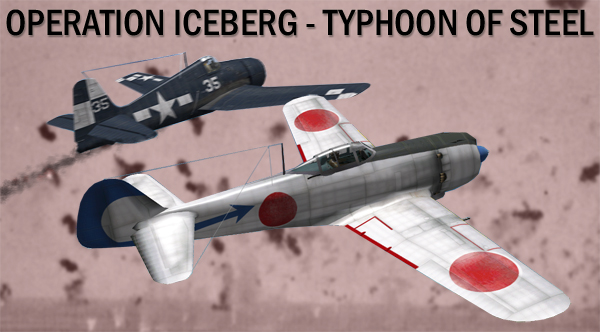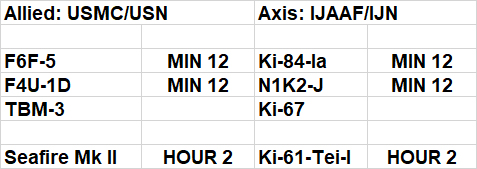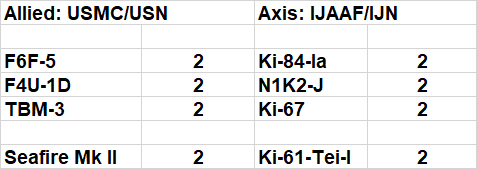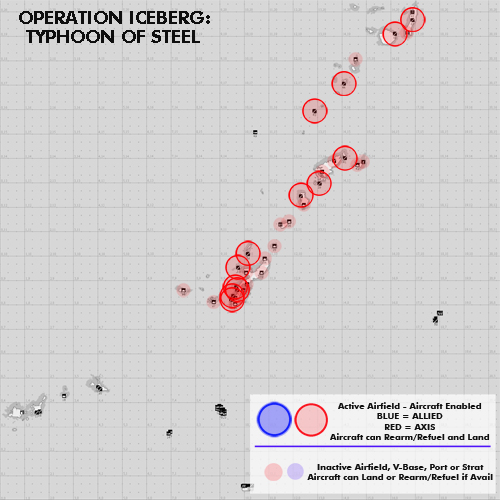Operation Iceberg: Typhoon of Steel

April 1st, 1945
The largest seaborne invasion fleet of 1,300 ships approached the island of Okinawa as the Allies put into motion Operation: Iceberg. It would be the last amphibious invasion of the war. Its main objective was to capture the Ryuku Islands of Okinawa and set up a staging area for the inevitable invasion of mainland Japan.
The Battle itself has been referred to as the “Typhoon of Steel†for the sheer ferocity of the engagement. In the air above the islands the Allies saw the largest kamikaze attacks of the war thus far while the sea was clogged with the largest invasion force ever assembled to date.
Between Easter Sunday and May 25th seven major kamikaze attacks were committed with nearly 1,500 planes. Japanese opposition had been fairly light for the first few days but were stepped up in the way of a 400 aircraft strike on April 6th. Between March 26th and April 30th, 20 American ships were sunk and 157 damaged by enemy action.
The Japanese also launched operation Ten-Go using the super battleship Yamato. Its mission was to breach the Okinawa invasion force and beach themselves upon the shore. The Yamato task force was spotted by US submarines and on April 7th she was sunk by over 300 naval aircraft long before she could reach the besieged island. Only 10 US Aircraft and 12 Airmen were lost for the loss the Yamato, the light cruiser Yahagi and four destroyers.
The bitter Island fighting lasted 82 days and by the 21st of June the island was in Allied hands. By the end of the assault the Japanese air force supporting Okinawa was non-existent as the Allies stepped up their attacks on the mainland of Japan. Okinawa was the bloodiest battle of the Pacific War and the deadliest of WW2 for the US Navy.
In the air, the US lost over 700 aircraft to all reasons during the three month period of the assault. Some historians believe that the casualties seen at Okinawa were seen as the one of the critical decision pieces for the use of the atomic weapons against Japan less than 2 months later.
This FSO is set during the Invasion of Okinawa, Operation: Iceberg, from April to June 1945.

PLANE SET:

- F4U-1D - 1000lb Bombs Disabled
- F6F-5 - 1000lb Bombs Disabled
- Ki-67 - Torpedo Only
- TBM-3 - Torpedo Only
AIRCRAFT SCORING:

OBJECT SCORING:


*Ship points doubled when sunk by Torpedo.
ACE MISSIONS:
Each side will have one mandatory Ace mission per frame. These frames will represent notable pilots of the time and theater. One pilot from each side will designated an "Ace" Pilot. They must fly the Aces listed aircraft. The Aces must be relayed to the Admin CM before launch. They will be scored as follows.
Ace Pilot = 20 Points
Ace Pilot Kills = 20 Points
So for example if an Ace Pilot is shot down they are worth 20 points to the other side. Like wise, every victory an Ace Pilot lands they will be rewarded 20 points.
ALLIED ACES
FRAME 1 – F6F-5 - Lt. Eugene A. Valencia (USN)– Valencia began his combat career in the F6F-5 aboard the Essex and at the end of his first cruise his score stood at 7 with combat at Rabaul and Truk. During his second tour with VF-9 Valencia and his fighter division scored 43 of VF-9s 130 kills. He also made ace in a day with 6 kills over Japan on April 17 1945. Valencia retired in 1962 and passed away during an Aces Reunion in 1972.
FRAME 2 – F4U-1D – Capt. Howard Finn (USMC) – Finn was part of VMF-124, the first squadron to take the F4U Corsair into combat in February 1943 at Guadalcanal. He had 5 kills and was an ace at the end of his first tour. In December of 1944 he returned for a tour on the USS Essex where he would score another kill over Japan February 25th 1945. Finn would fight in Korea flying Corsairs as well. He retired as a Full Colonel in 1969.
FRAME 3 – F6F-5 - Lt John M. Wesolowski (USN) – A veteran of the of the Guadalcanal campaign, he scored 5 victories in the Solomon’s with VF-5 flying the F4F-4 Wildcat. He then went stateside for 2 years as an instructor before returning to the Pacific in January 1945 with VBF-9. He claimed two more victories in the fighting at Okinawa, one of them a N1K2 on April 11 1945, the only to be recorded by the Yorktown’s Air Group.
AXIS ACES
FRAME 1 – KI-84-IA –Katsuaki Kira (IJAAF) – Kira flew in nearly every JAAF campaign, Manchuria, Dutch East Indies, New Guinea and the Philippines. Kira would encounter the famed US P-38 Ace Dick Bong and do battle with the elite 49 FG. His unit was destroyed in the Philippines and he would withdraw to Formosa. Kira would last see combat in the skies over Okinawa. He survived the war with 21 kills.
FRAME 2 – A6M5B – Takeo Tanimizu (IJN) – Tanimizu was transferred to the Shokaku air group in February 1943, but would not engage an enemy aircraft until November 1943, claiming two P-38s over Rabaul. Tanimizu returned to Japan as an instructor and then to Formosa where he was injured after a low bail out. He returned to Japan and was put on home defense duty in Kyushu. He survived the war and claimed 32 victories.
FRAME 3 – N1K2-J - Shoichi Sugita (IJN) – Sugita saw fierce action in the Solomons and became a leading ace in the campaign and flew in the infamous Yamamoto mission. Sugita continued to fight on in the Carolines, Marianas and scored numerous kills in the Philippines. Sugita was killed while trying to take off on April 15th 1945 during a US raid on Kamikaze bases in Kyushu. He claimed over 120 kills, but was credited with 70.

SETTINGS:
- Okinawa Terrain
- Okinawa Terrain
- Icon Range – Friendly 3k, Enemy 3k.
- No Radar
- Fighter and Bomber Warning Range - 63360 (12 miles)
- Tower Range – 63,360 (for display to match the above Fighter and Bomber Warning)
- External view for bombers (F3) - On
- Friendly Collisions - Off
- Enemy Collisions - On
- Kill Shooter - Off
- Fuel - 1.0
- Ack - 0.3
- Formations - DISABLED
- Bombsite calibration - Main Arena Standard
- No Radar
- Fighter and Bomber Warning Range - 63360 (12 miles)
- Tower Range – 63,360 (for display to match the above Fighter and Bomber Warning)
- External view for bombers (F3) - On
- Friendly Collisions - Off
- Enemy Collisions - On
- Kill Shooter - Off
- Fuel - 1.0
- Ack - 0.3
- Formations - DISABLED
- Bombsite calibration - Main Arena Standard
- Stall Limiter - Enabled
- Visibility - 17 miles
- Object Downtime – full (200)
- Winds - None
- Game Clock:
Frame 1: 06:00
Frame 2: 12:00
Frame 3: 16:00
- Object Downtime – full (200)
- Winds - None
- Game Clock:
Frame 1: 06:00
Frame 2: 12:00
Frame 3: 16:00
Design by Will "Nefarious" Hyman